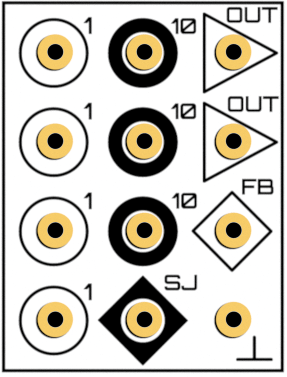Difference between revisions of "Summer"
m |
m |
||
| Line 1: | Line 1: | ||
[[File:Greek uc sigma.svg|thumb|120px|The greek symbol ''Sigma'' is the mathematical notation for a sum]] | [[File:Greek uc sigma.svg|thumb|120px|The greek symbol ''Sigma'' is the mathematical notation for a sum]] | ||
| − | A '''Summer''' is an elementary computing element of an analog computer. It carries out a '''Summation''', as in <code>a + b = c</code>. Here, <code>a</code> and <code>b</code> are called the ''summands'' and <code>c</code> is the ''sum''. [[The Analog Thing]] | + | A '''Summer''' is an elementary computing element of an analog computer. It carries out a '''Summation''', as in <code>a + b = c</code>. Here, <code>a</code> and <code>b</code> are called the ''summands'' and <code>c</code> is the ''sum''. [[The Analog Thing]] features four summers, allowing four summations in a circuit. |
Summation in analog computers always falls back on ''Kirchhoffs Law'', which itself is an application of conservation of current, or electrons, in particular. In a summing point (''summing junction''), the sum of the incoming and outgoing currents have to sum to zero. For more details, please refer to [[Literature|Analog computing literature]]. | Summation in analog computers always falls back on ''Kirchhoffs Law'', which itself is an application of conservation of current, or electrons, in particular. In a summing point (''summing junction''), the sum of the incoming and outgoing currents have to sum to zero. For more details, please refer to [[Literature|Analog computing literature]]. | ||
Revision as of 08:25, 30 July 2021
A Summer is an elementary computing element of an analog computer. It carries out a Summation, as in a + b = c. Here, a and b are called the summands and c is the sum. The Analog Thing features four summers, allowing four summations in a circuit.
Summation in analog computers always falls back on Kirchhoffs Law, which itself is an application of conservation of current, or electrons, in particular. In a summing point (summing junction), the sum of the incoming and outgoing currents have to sum to zero. For more details, please refer to Analog computing literature.
Basic Usage of a Summer on The Analog Thing
- Circles represent inputs, triangles represent outputs.
- Put each quantity you want to sum into a different circle. Do not stack connectors on the inputs.
- There are two input weights available:
1and10. Choose1in case you don't know what to do. Ignore the black inputs saying10. This way you can use each summer to sum up to four quantities. - There are two output slots. You can use both of them as you like and stack connectors however you like.
- For the time being, ignore the slots
SJandFB. In the lower right, you get some ground (logical zero). You can also ignore it.
![]() Attention: Make sure the sum of your inputs does not exceed the machine unit (±10V), otherwise an overload occurs (indicated by the OL LED)
Attention: Make sure the sum of your inputs does not exceed the machine unit (±10V), otherwise an overload occurs (indicated by the OL LED) ![]() . See Logic levels for details.
. See Logic levels for details.
Extended Usage of a Summer
- If you choose input weight 10, you perform an amplification of this input. For details, see below.
- ...
Mathematics about analog summing
sum = weight1 * input1 + weight2 * input2 + ...
Other summers in The Analog Thing
Inverters are electronically identical to summers. With their summing junctions, they can be used as summers if no more summers are available. See the article about Inverters and the XIR for more details. The Integrators are by definition also summing but cannot be stopped from integrating except in IC mode (see Modes).

